A Guide to Civil War Collections in Mobile, Alabama
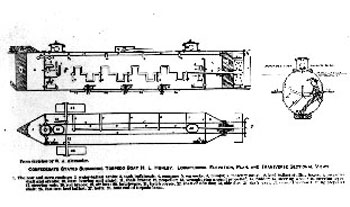 Schematic drawing of the interior of the Hunley.
Schematic drawing of the interior of the Hunley.
Photograph courtesy of The Museum of the Confederacy.
This guide describes primary source materials held in various research facilities in Mobile: The Doy Leale McCall Rare Book and Manuscript Library, the Historic Mobile Preservation Society, the Mobile County Probate Court Archives and Records Department, the Mobile Municipal Archives, the Mobile Public Library, Local History and Genealogy Division, the Roman Catholic Archdiocese of Mobile Chancery Archives, and Springhill College Archives.
This guide was prepared by Anthony Donaldson, 2003.
INTRODUCTION
Mobile has a rich documentary heritage which attracts many researchers each year. This guide will assist those interested in primary sources relating to the Civil War by providing information about our most commonly consulted research facilities with a summary of their holdings. We have included phone and fax numbers, mailing and web site addresses, and hours of operation so that researchers can contact the facilities before their arrival if they wish. Few cities Mobile's size can offer such a diversity of archives, libraries, and other research facilities. We hope that this guide will help visitors and Mobilians alike make full use of the rich heritage which all these institutions are preserving.
THE DOY LEALE MCCALL RARE BOOK AND MANUSCRIPT LIBRARY
University of South Alabama
5901 USA Drive North, Suite 300
Mobile, AL 36688
(251) 341-3900
E-Mail: mccalllib@southalabama.edu
Web site: https://www.southalabama.edu/libraries/mccallarchives/
Hours: Monday-Friday, 8 A.M.-noon, 1-5 P.M.
Access: Advance appointment requested
The Doy Leale McCall Sr. Papers are still undergoing processing, however the collection consists of approximately one million documents related to Alabama's Black Belt region. One portion of the collection, the Pickens Papers, includes material on Alabama's third governor, Israel Pickens, Israel Pickens' brothers and his nieces and nephews. Among the myriad subjects found within the Pickens Papers are slavery, Reconstruction and the Civil War. The documents date from 1808 to 1944 [bulk 1820-1899]. A guide to the Pickens Papers is available.
The Velma and Stephens G. Croom Collection includes correspondence between various Croom family members and friends from 1840 to 1906. Cicero Stephens Croom served in the Confederate Army as an Assistant Adjutant General to General John H. Forney during the Civil War. Croom corresponded with family and friends while he served in virtually every theater of the war from 1861 to 1865. He also kept a journal during the siege of Vicksburg, Mississippi, in April 1863. Stephens' sister, Elizabeth, married Dr. Charles Edward Bellamy who served as a physician in the Confederate Army, and they also corresponded with family members during the war. An advance appointment is required to view this collection.
The Katharine Crampton Cochrane Collection includes approximately a dozen letters written by Dr. Orson Lucius Crampton who served as a physician in the United States Army and was stationed in Mobile immediately after the Civil War. In his letters he made observations about Fort Gaines as well as the city of Mobile in the Spring of 1865. The collection also contains military orders and other papers related to Crampton's service in the Union Army.
Confederate Soldiers, Sailors and Civilians Buried in Northern Cemeteries (National Archives Microfilm No. 918)
Government Street Presbyterian Church Records include session minutes and register books dating from 1831 to 1979. The registers contain records of communicants, baptisms, marriages, and deaths. (microfilm)
The Illinois Central Gulf Railroad Records include a general journal and two ledgers of the Mobile and Ohio Railroad covering the years 1861 to 1865.
The Correspondence of Mark Lyons (1840-1887), Confederate States Army, February 18, 1861 to June 19, 1865, includes letters addressed to his fiancee (and later his wife) Amelia Horsler (1845-1916). Lyons first period of service began at Camp Beulah, Mobile. His was in Mississippi through 1862, resigned from the army, and married Amelia Horsler in 1863. He then re-enlisted in May 1864 and was stationed at various batteries in the defenses of Mobile until the end of the war. The letters have been transcribed by a relative. Some background about Mark Lyons and historical notes about the activities of the Confederate Army are included.
The Papers of Daniel Geary (c. 1812-1892), Confederate States Army, September 1861 to May 14, 1865, include day-books, letter-books, orders, invoices, personnel rosters, and some personal correspondence. Also included are Geary's personal receipt books from 1839 to 1891. Of particular interest within the collection is an 1852 Odd Fellow Certificate, a signed Parole of Honor in which Geary swore to cease his service with the Confederate Army, and a diary by Charles Brother, a Union officer, describing the Battle of Mobile Bay.
The Mobile County Circuit Court Records include individual case files and bound volumes of minutes, final records, etc. The materials date from ca. 1830 to ca. 1917. An inventory is available on this web site.
St. Francis Street Methodist Church Records include births, deaths, and marriages, as well as historical information on ministers who served the church during the war. (microfilm)
The McCall Library also has reproductions of original maps from the National Archives and the Library of Congress that show Confederate fortifications in Mobile and the Blakeley area as well as original prints and copies of engravings from such publications as Harper's Weekly.
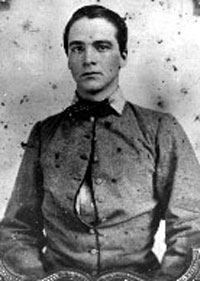 Cicero Stephens Croom (1839-1884).
Cicero Stephens Croom (1839-1884).
The Doy Leale McCall Rare Book and Manuscript Library.
THE HISTORIC MOBILE PRESERVATION SOCIETY ARCHIVES
Address: Minnie Mitchell Archives Building, 300 Oakleigh Place, Mobile, Alabama 36606
E-Mail: hmps@bellsouth.net
Web site: http://www.historicmobile.org/
Access: Currently unavailable
The Historic Mobile Preservation Society holdings include maps of the city of Mobile during the Civil War that show Confederate defenses for the city, newspaper clippings, military passes, several Confederate Quartermaster reports, invoices, letters, and receipts, as well as diaries of Confederate soldiers. Especially noteworthy are two diaries by John B. Dennis recorded from 1862-1863. Dennis was a member of the Hinson Guards formed in Mobile. The unit later became part of the 43rd Alabama Infantry. The Society also has the 1865 diary of Joseph A. Dennis as well as the diary of John A. De Pras recorded in 1862. All three men were from Mobile.
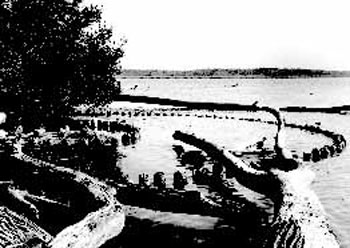 Remains of battery Huger located near Spanish Fort
Remains of battery Huger located near Spanish Fort
between the Blakeley and Apalachee rivers.
Louis Brassell Collection, The Doy Leale McCall Rare Book
and Manuscript Library.
THE MOBILE COUNTY PROBATE COURT ARCHIVES/RECORDS DEPARTMENT
Location:109 Government Street, Mobile, Alabama 36602
Mailing Address: P.O. Box 7, Mobile, Alabama 36601
E-Mail: probatecourt@probate.mobilecountyal.gov
Web site: http://probate.mobilecountyal.gov/records.asp
Hours: Monday-Friday 8 A.M.- 5 P.M.
Access: An appointment is not necessary.
The records listed below are available on microfiche only.
Fort Morgan and Fort Gaines Repairs include shoreline measurements, detailed drawings for repair, correspondence, and maps of the Confederate lines of defense.
Daily Diary of Captain J. Ernest Meiere (1862-1864) contains documentation primarily related to the Mobile Marine Barracks. It includes ship inspections, reports, requisitions, requests for supplies, court-martial/desertion records, and correspondence.
The Run-away Slave Book (1857-1865) is a record of slaves incarcerated in the Mobile City Jail as run-aways. It contains the name of the slave and owner, their residence, the person who recovered the slave, and the place where the slave was taken.
Petitions to Become a Slave (1860-1862). These records identify free persons of color who petitioned to become slaves in order to remain in Alabama pursuant to legislation passed in 1860.
Amnesty (1865) and Proclamation Oaths (1868). Finding themselves "men without a country" following the end of the Civil War, members of any branch of the Confederate forces signed these oaths to restore their citizenship rights.
Hall of Lee Benevolent Association Ledger and Minute Books (1875-1882). The records of the "Hall," a Confederate veterans organization, include a eulogy delivered at the funeral of Admiral Raphael Semmes, a history of the organization, and membership lists.
Confederate Pensioner's Book (1915-1919) contains names and addresses of persons receiving Confederate pensions from the state.
Probate Court minute books, mortgage books, deed books, and marriage license books also contain documents from the Civil War era.
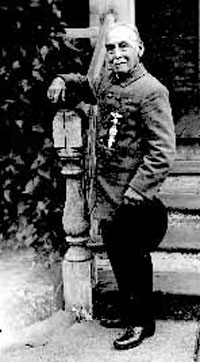
Louis Augustus Herpin, last survivor of the Battle
of Mobile Bay, was in his nineties when this photo
was made. Erik Overbey Collection, The Doy Leale
McCall Rare Book and Manuscript Library.
THE MOBILE MUNICIPAL ARCHIVES
Location: 457 Church Street, Mobile, Alabama 36602
Mailing Address: P.O. Box 1827, Mobile, Alabama 36633
E-Mail: archives@cityofmobile.org
Web site: Roman Catholic Archdiocese of Mobile Chancery Archives
Hours: Monday-Friday 8 A.M.- 5 P.M.
Access: An appointment is not necessary.
The Mobile Municipal Archives has a variety of records pertaining to city government as well as numerous other records concerning the area's general history.
Record Group 3 - Records of the Mayor, Board of Aldermen, and Common Council, 1839-1879
General Files, 1839-1879. This series contains letters, reports, ordinances, resolutions, petitions, and other materials relating to the daily operations of city government. (22 cubic ft.)
Passenger Lists, 1838-1863. Lists of passengers on vessels arriving in Mobile. Names of passengers, their place of birth or nationality, age, occupation, and last place of residence are usually given. (located in bound volumes and on microfilm)
Minutes of Meetings of the Board of Aldermen, 1850-1869. Minutes of meetings listing members present, matters discussed, reports received, and ordinances and resolutions passed. (microfilm)
Index to Minutes of the Meetings of the Board of Aldermen, 1858-1861.
Minutes of the Common Council, 1853-1879. Minutes of meetings listing members present, matters discussed, reports received, and ordinances and resolutions passed. (microfilm)
Newspaper Clippings of the Board of Aldermen, Common Council and Joint Convention Meetings, 1811-1873. Clippings of articles concerning meetings held by city government. (microfilm)
Ordinances, 1854-1863. Copies of ordinances passed by the Board of Aldermen and Common Council. (microfilm)
Record Group 8 - Records of the Finance Department
Journals, 1837-1866. Daily record of receipts and expenditures. (microfilm)
Ledgers, 1846-1876. Summaries of debits and credits for the year. Many ledgers contain indexes. (microfilm)
Treasurer's Receipt Book, 1859-1861. Receipts for moneys received from the city treasurer. Each handwritten receipt is signed by the person receiving moneys and lists the amount received and the services rendered.
Cash Books, 1861-1969. Daily record of receipts and expenditures. (microfilm)
Cash Books For City Markets, 1865-1866. Record of rents and huckster ticket fees paid by vendors at the city markets. (microfilm)
Record Group 9 - Records of the Revenue Department
Tax Books, 1829-1954. Lists names of taxpayers, the kinds and value of properties owned, and the amounts paid. (microfilm)
Tax Assessment Books, 1838-1860. Lists the names of property owners, the kinds of property owned, and its assessed value. (microfilm)
City Tax Cash Books, 1857-1898. Lists the names of the taxpayers, the types of taxes paid, and the total tax bill. (microfilm)
Record of Bonds Issued, 1830-1884. Record of the types of bonds issued, including city debt, wharf, and railroad bonds, their amounts, rates of interest, names of purchasers, and the dates they were issued, redeemed, and destroyed. (microfilm)
Record Group 15 - Records of the Department of Parks, Recreation and Culture
Sexton's Reports, Burial Permits, and Death Certificates, 1848-1907. Includes monthly burial reports of the city sexton listing names of the deceased, their age, color, graveyard where buried, lot number, fees paid, and the name of the funeral home. (microfilm)
Register of Lots Sold, 1838-1861. Indicates who purchased lots 1 through 16 in Magnolia Cemetery.
Record Group 17 - Records of the Mobile Police Department
Guard House Dockets, 1859-1863. Daily record of prisoners confined to the guard house. Lists name of offender, complaint, by whom committed, time, judgment, fine paid, and other remarks. (microfilm)
Other records located at the Mobile Municipal Archives include:
Transcripts of City Documents, 1845-1884. Typed transcriptions of documents by workers of the Works Progress Administration during the 1930s. Many of the original documents no longer exist. (2 vols.)
Passenger Lists, 1820-1905 (with gaps). These records consist of customs passenger lists, transcripts, and abstracts of customs passenger lists, immigration passenger lists, and indexes to some of these lists. (National Archives microfilm)
Alabama Census- City of Mobile, Mobile County 1860 (microfilm)
Death Notices from Mobile Newspapers, 1843-1865, compiled by Charles J. Torrey. (microfilm)
Death Notices: Local and Foreign, 1860-1869, published by the Mobile Genealogical Society.
Magnolia Cemetery Deed Book, ca. 1832-1862. (microfilm)
Correspondence and Records of the Superintendent of Lights 1838-1880 (National Archives microfilm)
Mobile Weekly Advertiser, September 1865. (microfilm)
The Munger/Baumhauer Family Papers, a small collection of personal papers, include Confederate military passes and military orders.
The Municipal Archives also has numerous maps showing Confederate fortifications in Mobile and area campsites, as well as several prints illustrating the Battle of Mobile Bay.
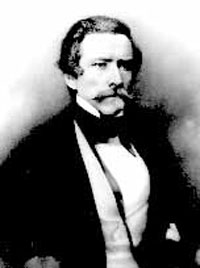 Raphael Semmes (1809-1877). Erik Overbey Collection,
Raphael Semmes (1809-1877). Erik Overbey Collection,
The Doy Leale McCall Rare Book and Manuscript Library.
MOBILE PUBLIC LIBRARY, LOCAL HISTORY AND GENEALOGY DIVISION
Location: 704 Government Street, Mobile, Alabama 36602-1403
E-Mail: lhgservices@mplonline.org
Web site: https://www.mobilepubliclibrary.org/locations-hours/local-history-genealogy
Hours: Monday-Saturday, 9 A.M.- 6 P.M.
Access: An appointment is not necessary.
The Journal of George Townley Fullam, July 29, 1862-June 14, 1864. Fullam was the boarding officer on the Confederate raider CSS Alabama which was commanded by Confederate Admiral Raphael Semmes. (original on microfilm, published version also available)
Raphael Semmes Family Papers, 1859-1913. Admiral Raphael Semmes was the commander of the Confederate raider CSS Alabama and lived in Mobile after the Civil War. The papers include the log of the CSS Alabama. (Alabama Department of Archives and History microfilm)
Records of the CSS Florida, 1862-1864. The Florida was a Confederate raider. Its records include ship logs, ship engineer's logs, medical logs, court-martial records, paymaster receipts, and crew lists. (National Archives microfilm)
Adelaide Chaudron's Journal of the Military Aid Society, May 1861-April 1865. The Military Aid Society was formed by several prominent ladies in Mobile. It raised money and provided supplies for the Confederate Army and families of Confederate soldiers. Chaudron, the society's secretary, recorded most of the entries in the journal. (microfilm)
The Local History and Genealogy Department of the Mobile Public Library holdings also include manuscript census records (microfilm), Mobile newspapers (microfilm), and Mobile City directories.
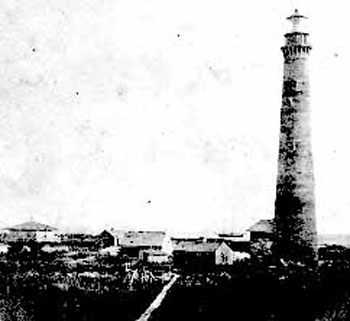 Sand Island lighthouse in Mobile Bay, built 1859, was destroyed by Confederate forces
to prevent capture by
Sand Island lighthouse in Mobile Bay, built 1859, was destroyed by Confederate forces
to prevent capture by
federal troops. Ft. Morgan Collection, The Doy Leale McCall Rare Book and Manuscript
Library.
THE MUSEUM OF MOBILE
Location: 111 South Royal Street, Mobile, Alabama 36602
Mailing Address: P.O. Box 2068, Mobile, Alabama 36652-2068
E-Mail: museum@cityofmobile.com
Web site: http://www.museumofmobile.com/
Hours: Contact the museum for research hours.
Access: Advance appointment required.
The Thomas M. McMillan Collection contains approximately 1,000 documents (1862-1865) and includes Confederate military correspondence concerning the defense of Mobile and Mobile Bay including forts Morgan and Gaines; letters from civilians concerning the impressment of property and slaves; correspondence between Union naval commander Admiral David Farragut and his officers, and letters from Confederate and Union soldiers to their families. The collection also includes documents relating to other theaters of the war outside the Mobile area.
The Home Journal Newspaper (May 1864- August 1865) was published anonymously by Mobilians. According to its by-line the hand-written monthly journal was devoted to the intellectual improvement of the family. The seven issues in the collection contain editorials on health, letters to the editor, articles on home industry, a poet's corner section, an agricultural section as well as cooking recipes. Some of the articles also describe conditions in Mobile during the Civil War. The journal had anonymous correspondents, one of whom reported on a trip to Fort Morgan in May 1864. Other correspondents reported from areas outside Mobile such as Gainesville, Alabama. (microfilm)
The Museum of Mobile also has a number of miscellaneous maps of Mobile.
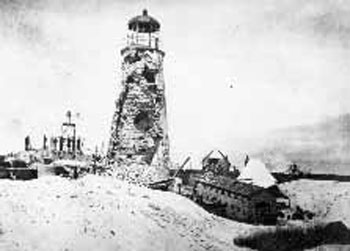 Ft. Morgan after its surrender, September 1864.
Ft. Morgan after its surrender, September 1864.
National Archives, No. 77-F-82-74.
ROMAN CATHOLIC ARCHDIOCESE OF MOBILE CHANCERY ARCHIVES
Location: 400 Government Street, Mobile, Alabama 36602
Web site:http://www.mobarch.org/archives/
Hours: By appointment.
Access: Advance appointment and special permission is required to visit the archives.
Bishop John Quinlan Papers, 1859-1883. John Quinlan, consecrated the second bishop of Mobile on December 4, 1859, at the age of thirty-three, supported the South's secession from the Union and the Confederate States of America. His papers contain personal correspondence with other Catholic clergy in the South, the nation, and Europe concerning the administration of the Church in Mobile. (Many of the documents are written in French.)
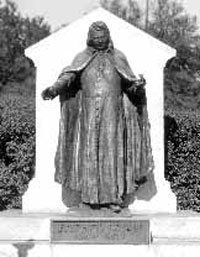 Statue of Father Ryan (1839-1886), "Poet-Priest" of the Confederacy.
Statue of Father Ryan (1839-1886), "Poet-Priest" of the Confederacy.
Erik Overbey Collection, The Doy Leale McCall Rare Book and Manuscript Library.
SPRING HILL COLLEGE ARCHIVES
Address: Burke Memorial Library, 4000 Dauphin Street, Mobile, Alabama 36608
E-Mail: archives@shc.edu
Web site: https://libguides.shc.edu/archives
Hours: Monday - Friday, 8:00 A.M. - 3:30 P.M.
Access: Advance appointment required.
The Annals of Spring Hill College by Reverend Andrew Cornette and Others (1872). Father Cornette taught Physics, Chemistry, and Mathematics at Spring Hill College from 1856 to 1862 and from 1864 to 1870. During the Civil War he served as a chaplin in the Confederate Army. The Annals are translations of Reverend Cornette's diary, originally written in French, containing information about life at the College during the war, as well as about the involvement of Jesuit priests as chaplains.
The Vice-President's Diary (1859-1887) was an official record kept by college officials. It reveals how the Civil War affected Mobile, Spring Hill College, and its students. The diary mentions names of some of the students who ran away to join the Confederate Army and describes visits by recruiters.
The Confederate States Laboratory Formulae Notebook by Dr. F. J. B. Rohmer lists formulae that he prepared for medicines. Rohmer was a physician at Spring Hill College from 1856 to 1885 and was appointed Surgeon and Botanist by the Confederate States of America. Rohmer maintained a laboratory in Mobile where he manufactured medicine for the Confederacy. (This material will be available to the public at a later time on the Spring Hill College Library/Archives web page.)
The Memoirs of Father Henry Churchill Semple record his experiences as a student at Spring Hill College (which also had a pre-high school course of preparation) from 1864 to 1866. The memoirs contain observations about the lives of the students during the war. Father Semple (1853-1925) wrote a series of articles on his days at Spring Hill for the school newspaper (The Springhillian) in 1925.


